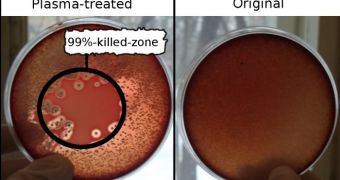A new study carried out by a team of Russian and German scientists, concluded that cold plasma jets could be an efficient replacement for antibiotics, in treating multi-drug resistant infections.
The researchers proved than a ten-minute treatment with low-temperature plasma managed to kill drug-resistant bacteria that were causing wound infections in rats, and also boosted the healing process of these wounds.
The team at the Gamaleya Institute of Epidemiology and Microbiology in Moscow, conducted an experiment testing the impact of a low-temperature plasma torch against bacterial species which included Pseudomonas aeruginosa and Staphylococcus aureus.
The results proved that plasma was lethal to up to 99% of bacteria in laboratory-grown biofilms after only five minutes.
Also, nearly 90 % of the bacteria (on average) infecting skin wounds in rats, was killed after ten minutes, AlphaGalileo reports.
Staphylococcus aureus and Pseudomonas aeruginosa are two very dangerous bacteria, that cause chronic wound infections and that develop resistance to antibiotics by growing together in protective layers called biofilms.
The leader of the research, Dr Svetlana Ermolaeva said that the latest findings concerning cold plasma (at temperatures of 35-40°C) turned it into a viable option for treating infections.
“Cold plasmas are able to kill bacteria by damaging microbial DNA and surface structures without being harmful to human tissues,” she explained.
“Importantly we have shown that plasma is able to kill bacteria growing in biofilms in wounds, although thicker biofilms show some resistance to treatment.”
Plasma is the fourth state of matter after solids, liquids and gases, and it forms when high-energy processes strip atoms of their electrons to produce ionized gas flows at high temperature.
Hot plasmas are already used to disinfect surgical instruments and theyThey have an increasing number of technical and medical applications and hot plasmas are already used to disinfect surgical instruments.
Plasma technology could eventually represent a better alternative to antibiotics, according to Dr Ermolaeva.
“Our work demonstrates that plasma is effective against pathogenic bacteria with multiple-antibiotic resistance - not just in Petri dishes but in actual infected wounds,” she said.
“Another huge advantage to plasma therapy is that it is non-specific, meaning it is much harder for bacteria to develop resistance.
“It's a method that is contact free, painless and does not contribute to chemical contamination of the environment.”
The study was published this week in the January issue of the Journal of Medical Microbiology.

 14 DAY TRIAL //
14 DAY TRIAL //